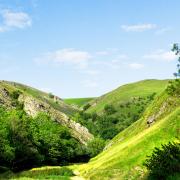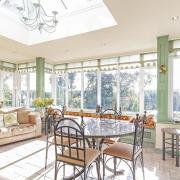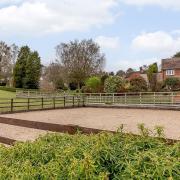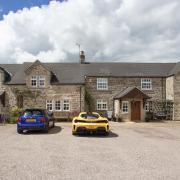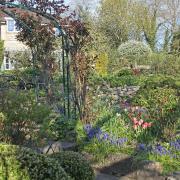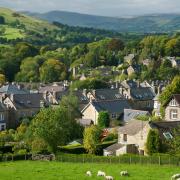Robert Innes-Smith visits Thrumpton Hall - an idyllic early 17th century brick and stone-faced house situated on the borders of Nottinghamshire and Derbyshire
Though this lovely country teems with industry, every prospect is idyllic and chimneys in the distance become tall obelisks.' Thus wrote Sir Osbert Sitwell about the views from Renishaw Hall at the beginning of his autobiography Left Hand Right Hand! With the decline in industry there are no longer any chimneys on the horizon at Renishaw.There is some similarity with Thrumpton Hall on the borders of Nottinghamshire and Derbyshire. True, 'every prospect is idyllic' and in the two acres of glorious gardens of Thrumpton Hall one might be a hundred miles away from teeming industry, for in a maelstrom of motorways, dual carriage-ways, widened roads, an airport and a power station the survival of Thrumpton and its 250 acres of parkland intact is scarcely less than a miracle. It is a piece of real England to die for, flourishing still, and where one can forget the horrors of modern life in a matchless and romantic rural setting.Through the small, quiet village of Thrumpton (the road is a dead end) with its lovely church, the house is approached from a drive through two ornamental archways with a lake to the right, the entrance to the house being on the left. It is not until you see the South Front from the gardens that you can appreciate the full beauty of this early 17th century brick and stone-faced house with its gables, later given a Dutch face-lift, perhaps reflecting the advent of William and Mary.This house was built by one Gervase Pigot (whose elaborate monument is in the church), and altered and embellished by his son of the same name. The Pigots did not stay long and at the turn of the 17th century the estate was bought by a lawyer called John Emerton. Emerton's nephew and successor, John Wescomb Emerton, inherited in 1745, the year of the Jacobite Rising and was squire longer than any other owner, dying in 1823 after 78 years and just 14 years before the accession of Queen Victoria. A contemporary account of a ball given by one of the Wescomb ladies held at Thrumpton in 1840 perfectly captures the world of Jane Austen.The estate, after 1823, passed by descent in the female line to the 8th Lord Byron who had, in 1843, married Lucy Wescomb, the daughter of the Rev. William Wescomb, the last of his family in the male line to own Thrumpton. Thus the estate passed for a short time to the Byron family, distantly related to the poet. Lord and Lady Byron had no children and Thrumpton was inherited by their nephew the 9th Baron (1855-1917) who, again, had no children, so the estate once more went 'sideways' to his brother the 10th Lord Byron who was in Holy Orders. He was Vicar of Langford in Essex and while, as it were, 'in waiting' was Vicar of Thrumpton in 1914, succeeding his brother and so becoming 'Squarson' of the estate three years later. The 10th Lord married Lady Anna FitzRoy, sister of the 10th Duke of Grafton and a direct descendant of King Charles II.The later Byrons did not have much luck in producing heirs and the 10th Lord died childless in 1949. The estate was put up for sale and all seemed lost until his nephew, George Seymour (a member of the family of the Marquess of Hertford) and his wife Rosemary, youngest sister of the 9th Lord Howard de Walden, came to the rescue. George Seymour was the son of Lady Byron's sister Lady Victoria Seymour (n�e FitzRoy) and he and Rosemary pooled their resources and at great sacrifice bought the Thrumpton estate which George had known and loved all his life.An account of Thrumpton at this period in Miss Miranda Seymour's book In My Father's House vividly describes life at that time in the house. Dickens himself might have invented the names of some of the denizens of the Servants' Hall: Mr Crush, Mr Shotbolt and Miss Death.Miss Seymour's intriguing and bizarre book brings the history of Thrumpton up to the present. When her father George died his widow, the Hon. Mrs Seymour, inherited and she in turn has handed over the estate to her daughter but still lives in the house with her daughter and son-in-law, Mr Ted Lynch.As mentioned the main entrance is on the North Front and leads directly into the Great Hall. The Rev. Henry Thorold wrote: 'To dine in this room is like dining in hall in one of the smaller colleges at Oxford or Cambridge.' And so it is but, of course, much more informally. A frieze of coats of arms tells the story of the house in heraldic terms. The screens entrance at the west end of the Hall leads to the crowning glory of Thrumpton - the magnificent staircase heavily and splendidly carved. Few staircases of this size in England can match this one.The Library faces South with fine views of the garden in summer. In winter a blazing fire, the whiff of wood smoke and the enveloping warm brown cloak of calf-bound books makes this a perfect place for the family and the entertaining of guests. Easily overlooked is a small, modest bust of the 'King of the Turf' - Lord George Bentinck (1802-1848), friend of Disraeli, who cleansed the Augean stables of corrupt racing practices of the time. It is a reminder that the family has close family links with the Portlands of Welbeck. Elsewhere are portraits of the family.Still on the ground floor is the Oak Room which has panelling and carving dating from Stuart times. Hardly visible is a door to a secret staircase leading to a priest hole in the oldest part of the building.The grandest room in the house is the Saloon, reached from the first flight of the grand staircase. It was decorated by the son of the builder. The centrepiece is an 18th century classical marble chimneypiece and there are many fine portraits.Matching the splendour of the Saloon is the Dining Room with its rich red walls, and, of course, numerous historical portraits of the family and others. This is the scene of many glamorous and interesting dinner parties attended by friends and family with conversation flowing easily thanks to the splendid cellars.The present owner of Thrumpton, Mrs Ted Lynch, otherwise Miranda Seymour, is a prolific and successful writer with biographies of, among others, Mary Shelley, Robert Graves, Lady Ottoline Morrell and Henry James. To help keep the house going and to allow a wider section of the public to enjoy its ambience and its treasures, house tours can be organised and the main rooms are available for weddings and corporate events. One can even rent the house for a minimum of a week with use of swimming pool, tennis court and the garden and parkland.The park has a lake and the River Trent forms a boundary with a spectacular rushing weir. At the top of rising ground grand views can be enjoyed. April sees the opening of a remarkable lakeside pavilion.



